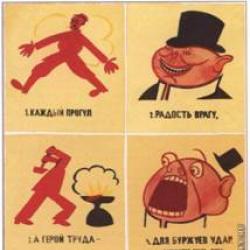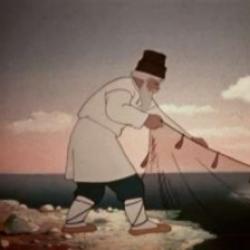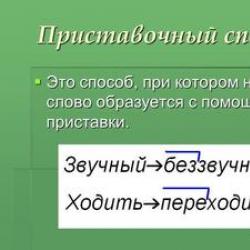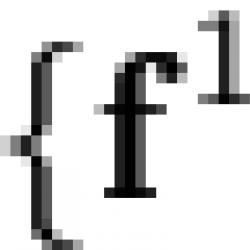Test work on literature on the topic “V. Rasputin “French Lessons”. Educational portal Test work on literature French lessons
1. The work says:
A.
B.
is:
A. pride;
B. homesickness;
B. stinginess.
B. ceases to be a child;
French language.
A. antithesis;
B. comparison;
B. allegory.
uses:
A.hyperbole;
B. irony;
B. metaphor.
A. constant epithets;
B. epithets;
B. logical definitions.
A. allegory;
B. comparison;
B. antithesis.
A. comparison;
B. irony;
B. antithesis.

Test based on the story by V. Rasputin “French Lessons”
1. The work says:
o additional classes in French;
A.
B. about the lessons of morality and kindness;
B.
about your favorite French lessons.
2. The action in the work takes place:
A. before the Great Patriotic War;
B. during the Great Patriotic War;
B. after the Great Patriotic War.
3. The narrator, who was not friends with anyone, believed that the main reason for his loneliness
is:
A. pride;
B. homesickness;
B. stinginess.
4. According to Lydia Mikhailovna, a person ages when:
A. ceases to be amazed at miracles;
B. ceases to be a child;
B. lives to an old age.
5. The true meaning of the game of “measuring”:
A. help from a teacher to a capable but hungry student;
B. the teacher’s desire to remember her childhood;
B. the teacher’s desire to interest the student in learning
French language.
6. Speaking about the characteristic features of the teacher’s voice and the voices of fellow villagers (“In our
they spoke to the village, tucking their voice deep into their guts, and therefore it sounded to their heart’s content, but
To Lydia Mikhailovna he was somehow small and light”; “... while I was studying, while I was getting used to
to someone else's speech, the voice sat down without freedom, weakened..."), the narrator used:
A. antithesis;
B. comparison;
B. allegory.
7. In the sentence: “Here I was adamant, I had enough stubbornness for ten” author
uses:
A.hyperbole;
B. irony;
B. metaphor.
8. In the sentence: “Already timid and shy by nature, at a loss from any
nothing..." the highlighted words are:
A. constant epithets;
B. epithets;
B. logical definitions.
9. The phrase: “The voice without freedom has sat down, weakened, like a bird in a cage” contains:
A. allegory;
B. comparison;
B. antithesis.
10. Verbal portraits of the main characters are located nearby in the text. Stylistic device
used by the author in this case:
A. comparison;
B. irony;
Test based on the work of V. Rasputin “French Lessons”.
Multiple Choice Questions
1. Determine the genre of the work:
a) story c) essay
b ) story d) memoirs
2. According to the boy, his independent life began:
a) at 10 years old b) at 16 years old
b) at 11 years old d) at 18 years old
3. The school where he studied was:
a) in the village b) in the regional center
b) in the village d) in the town
4. The narrator began to play for money in order to:
a) send them to mother c) buy milk
b) buy some candy d) to prove to the kids that he can play too
5. How much money did the hero of V. G. Rasputin’s story “French Lessons” win in “chiku”:
a) 5 rubles c) 100 rubles
b) 1 ruble d) 50 kopecks
6. What did the boy buy for himself with the money he won:
a) gingerbread c) milk
b) candy d) potatoes
7. The boy and the teacher played:
a) in "chiku" c) in dominoes
b) in “measurements” d) in cards
8. The teacher decided to play a game of chance with her student in order to:
a) earn money b) he was able to buy food for himself
b) gain the student’s trust d) feel like a child yourself
9. What fruits did the hero of the story see only in the picture:
a) strawberries b) bananas
b) apples d) raspberries
10. In French, the most difficult thing for a boy to do correctly was:
a) speak b) construct phrases
b) write d) translate texts
11. What artistic device does the author use in the phrase: “This makes her good and bad at the same time”:
a) metaphor b) personification
b) epithet d) antithesis
12. The teacher sent the boy a parcel containing:
a) new shoes c) pasta and apples
b) gingerbread and sweets d) milk and bread
Short answer questions
1.Name and patronymic of the French teacher.
2. A river in Siberia, where the action of V. G. Rasputin’s story “French Lessons” takes place.
3. Clothes that village children wore instead of jackets.
4. Homemade shoes, which the main character was so embarrassed about.
5. Which of the heroes of V. G. Rasputin’s story “French Lessons” does this portrait belong to?
“They were all about the same age as me, except for one - tall and strong, noticeable for his strength and power, a pariah with long red bangs.”
6. What did the boy’s mother buy when she sold the sewing machine?
7. "Following Vadik, like a shadow, was a big-headed, short-haired, stocky guy, nicknamed ... "
8. Which of the heroes of V. G. Rasputin’s story “French Lessons” does this portrait belong to?
“She was probably twenty-five or so then; I remember well her regular and therefore not too lively face with eyes narrowed to hide the braid in them; a tight, rarely fully revealed smile and completely black, short-cropped hair.”
9. The hero of V. G. Rasputin’s story “French Lessons”, who, “choking with joy,” betrayed the boy by telling him that he was playing for money.
10. The name of the driver of the “only lorry and a half on the collective farm” who brought the boy to the city.
11. « Three days later Lydia Mikhailovna left.” Where did Lydia Mikhailovna go?
12. To whom is V. G. Rasputin’s story “French Lessons” dedicated?
Tasks for working with text
V. G. Rasputin’s “French Lessons” uses dialect words, i.e. those that are used only in a given area; replace them with commonly used ones.
Remember an excerpt from V. G. Rasputin’s story “French Lessons”, copy it down, inserting words that suit the meaning instead of dots.
Among ……, already after ………… holidays, I received ……… at school by mail. When I opened it, taking the ax out from under the stairs again, there were tubes in it in neat, dense rows......... And below, in a thick cotton wrapper, I found......... …………….
I used to see…………. only on …………………, but I guessed that it was them.
Answers
Multiple Choice Questions
a) story
b) at 11 years old
c) in the regional center
c) buy milk
b) 1 ruble
c) milk
b) in “measurements”
c) he was able to buy his own food
b) apples
a) talk
d) antithesis
c) pasta and apples
Short answer questions
Tarpaulin boots.
Lydia Mikhailovna.
Uncle Ivan.
Anastasia Prokopyevna Kopylova.
Lydia Mikhailovna.
Tasks for working with text
2.
Among winter, already after Januaryholidays, I received a letter from schoolpackage.When I opened it, taking the ax out from under the stairs again, there were tubes in it in neat, dense rows.macaron. And below, in a thick cotton wrapper, I foundthree red apples.
I used to see apples only in the pictures, but guessed that it was them.
Test based on the story by V. Rasputin “French Lessons”.
1. Genre of the work:
a) memoirs;
b) story;
c) story.
2. The title of the work suggests that this is before us:
a) history of additional classes in French;
b) a story about the lessons of morality and kindness;
c) the young hero’s story about his favorite French lessons.
3. The action in the work takes place:
a) before the Great Patriotic War;
b) during the Great Patriotic War;
c) after the Great Patriotic War.
4. “Big-headed, crew-cut, stocky guy” is:
c) Fedka.
5. “The driver of the only lorry and a half on the collective farm” is:
b) Vasily;
6. The narrator, who was not friends with anyone, believed that the main reason for his loneliness is:
a) pride;
b) homesickness;
c) stinginess.
7. The narrator played chica to:
a) save money and send it to the village;
c) buy milk every day.
8. The young hero believed that the French words:
a) invented for punishment;
b) surprise with their uniqueness;
c) are not at all similar to Russian words.
9. According to Lydia Mikhailovna, a person ages when:
a) ceases to be surprised by miracles;
b) ceases to be a child;
c) lives to an old age.
10. The true meaning of the game of “measuring”:
a) help from a teacher to a capable but hungry student;
b) the teacher’s desire to remember her childhood;
c) the teacher’s desire to interest the student in learning French.
Answers: 1. b; 2. b; 3. in; 4. a; 5. a; 6. b; 7. in; 8. a; 9. b; 10.a
Quiz (test) on knowledge of the text of the story
V.G. Rasputin “French Lessons” (two versions) (6th grade)
Educational and methodological manual.
Potina Elena Vladimirovna,
Deputy Director for Educational Management, Teacher of Russian Language and Literature
GBOU secondary school No. 147 Krasnogvardeysky district of St. Petersburg
1 option
1. At what age did the hero begin his independent life?
2. What did Uncle Ilya give to our hero when he won 400 rubles on bonds?
3. What was the worst thing for the boy when he came home from school and was left alone?
4. What river flowed in the village where our hero’s mother was?
5. What was the name of the money game?
6. Why did the hero of the story need to drink milk?
7. What did the hero do with the money he won?
8. Who started the fight first?
9. “I knew that I was going to ………….., but the least ……………… was to once and for all come to terms with the fact that I was beaten and kicked out”
10. The second time, what did the hero need the ruble for?
11. A rare item that Lydia Mikhailovna had at home.
12. What was in the package that was left at school for the hero of the story?
13. Who collected this parcel?
14. “A person ages not when he reaches old age, but when he ceases to be …………..”
15. What game did the hero of the story play with the teacher?
16. Why did Lydia Mikhailovna have to leave?
17. What did the hero of the story receive in the second package? He had only seen it in pictures.
19. What was the name of the area?
Option 2
1. A rare item that Lydia Mikhailovna had at home.
2. What was in the package that was left at school for the hero of the story?
3. Who collected this parcel?
4. “A person ages not when he reaches old age, but when he ceases to be …………..”
5. The hero of the story, what game did he play with the teacher?
6. Why did Lydia Mikhailovna have to leave?
7. What did the hero of the story receive in the second package? He had only seen it in pictures.
9. Another name for the area.
10. At what age did the hero begin his independent life?
11. What did Uncle Ilya give to our hero when he won four hundred rubles on bonds?
12. What was the worst thing for a boy when he came home from school and was left alone?
13. What river flowed in the village where our hero’s mother was?
14. What game did you play for money?
15. Why did the hero of the story need to drink milk?
16. What did the hero do with the money he won the first time?
17. Who started the fight first?
18. “I knew that I was going to ………….., but the least ……………… was to once and for all come to terms with the fact that I was beaten and kicked out”
19. The second time, what did the hero need the ruble for?
20. Why did Lydia Mikhailovna decide to play with her student? How do you evaluate this action?
21. The main character of the story. What impression do you have about the character of the hero? How can you characterize his relationship with the guys and the teacher?
V.G. Rasputin “French Lessons” (1st century)
2. Bucket of potatoes
6. He had anemia
7. I bought a jar of milk
9. Humiliation, ...less humiliation
10. For bread
11. Radio with player
12. Pasta, a few lumps of sugar and two hematogen bars
13. Lidia Mikhailovna
14. "child"
15. “measurements”, “wall”
16. because of playing for money with a student
17. apples
18. from dinner
19. regional center
Answers to a quiz on knowledge of the text of the story
V.G. Rasputin “French Lessons” (2nd century)
1. Radio with player
2. Pasta, a few lumps of sugar and two hematogen bars
3. Lidia Mikhailovna
4. "child"
5. “measurements”, “wall”
6. Because of gambling with a student
8. from dinner
9. regional center
11. Bucket of potatoes
13. Angara
14. "Chica"
15. He had anemia
16. I bought a can of milk
18. Humiliation, ...less humiliation
19. For bread
Literature.
1. V.G. Rasputin "French Lessons"
State budgetary educational institution
secondary school No. 733
Moscow
Literature test
6th grade
V. G. Rasputin story “French Lessons”
Compiled by:
teacher of Russian language and literature
Afinogenova Olga Nikolaevna
Moscow 2014
Target: test students' knowledge of the text of the story. G. Rasputin “French Lessons” ; develop skills of independent work with text; awaken interest in the study of fiction.
Multiple Choice Questions
1. Determine the genre of the work:
a) story c) essay
b ) story d) memoirs
2. According to the boy, his independent life began:a) at 10 years old b) at 16 years old
b) at 11 years old d) at 18 years old
3. The school where he studied was:a) in the village b) in the regional center
b) in the village d) in the town
4. The narrator began to play for money in order to:a) send them to mother c) buy milk
b) buy some candy d) to prove to the kids that he can play too
5. How much money did the hero of V. G. Rasputin’s story “French Lessons” win in “chiku”:a) 5 rubles c) 100 rubles
b) 1 ruble d) 50 kopecks
6. What did the boy buy for himself with the money he won:a) gingerbread c) milk
b) candy d) potatoes
7. The boy and the teacher played:a) in "chiku" c) in dominoes
b) in “measurements” d) in cards
8. The teacher decided to play a game of chance with her student in order to:a) earn money b) he was able to buy food for himself
b) gain the student’s trust d) feel like a child yourself
9. What fruits did the hero of the story see only in the picture:a) strawberries b) bananas
b) apples d) raspberries
10. In French, the most difficult thing for a boy to do correctly was:
a) speak b) construct phrases
b) write d) translate texts
11. What artistic device does the author use in the phrase: “This makes her good and bad at the same time”:a) metaphor b) personification
b) epithet d) antithesis
12. The teacher sent the boy a parcel containing:a) new shoes c) pasta and apples
b) gingerbread and sweets d) milk and bread
Short answer questions
1.Name and patronymic of the French teacher. 2. A river in Siberia, where the action of V. G. Rasputin’s story “French Lessons” takes place. 3. Clothes that village children wore instead of jackets.4. Homemade shoes, which the main character was so embarrassed about.
5. Which of the heroes of V. G. Rasputin’s story “French Lessons” does this portrait belong to? “They were all about the same age as me, except for one - tall and strong, noticeable for his strength and power, a pariah with long red bangs.”
6. What did the boy’s mother buy when she sold the sewing machine?7. " Following Vadik, like a shadow, was a big-headed, short-haired, stocky guy, nicknamed ... " 8. Which of the heroes of V. G. Rasputin’s story “French Lessons” does this portrait belong to? “She was probably twenty-five or so then; I remember well her regular and therefore not too lively face with eyes narrowed to hide the braid in them; a tight, rarely fully revealed smile and completely black, short-cropped hair.”
9. The hero of V. G. Rasputin’s story “French Lessons”, who, “choking with joy,” betrayed the boy by telling him that he was playing for money.
10. The name of the driver of the “only lorry and a half on the collective farm” who brought the boy to the city.
11. « Three days later Lydia Mikhailovna left.” Where did Lydia Mikhailovna go?
12. To whom is V. G. Rasputin’s story “French Lessons” dedicated?
Tasks for working with text
V. G. Rasputin’s “French Lessons” uses dialect words, i.e. those that are used only in a given area; replace them with commonly used ones.
Dialectal
Remember an excerpt from V. G. Rasputin’s story “French Lessons”, copy it down, inserting words that suit the meaning instead of dots.
Among ……, already after ………… holidays, I received ……… at school by mail. When I opened it, taking the ax out from under the stairs again, there were tubes in it in neat, dense rows......... And below, in a thick cotton wrapper, I found......... …………….
I used to see…………. only on …………………, but I guessed that it was them.
Answers
Multiple Choice Questions
a) story
b) at 11 years old
c) in the regional center
c) buy milk
b) 1 ruble
c) milk
b) in “measurements”
c) he was able to buy his own food
b) apples
a) talk
d) antithesis
c) pasta and apples
- Lydia Mikhailovna. Angara. Sweatshirt. Teal. Vadik. Tarpaulin boots. Bird. Lydia Mikhailovna. Tishkin. Uncle Ivan. Kuban. Anastasia Prokopyevna Kopylova.
Tasks for working with text
Dialectal
2.
Among winter, already after Januaryholidays, I received a letter from schoolpackage.When I opened it, taking the ax out from under the stairs again, there were tubes in it in neat, dense rows.macaron. And below, in a thick cotton wrapper, I foundthree red apples.
I used to see apples only in the pictures, but guessed that it was them.
Used materials.
- Egorova N.V., Makarova B.A. Universal lesson developments in literature: 6th grade. – M.: VAKO, 2011. – 400 p. Literature lessons in 6th grade: book. for the teacher / O.A. Eremina. – M: Education, 2008. – 319 p. Literature. 6th grade Textbook for general education. institutions. At 4 o'clock / V. P. Polukhina; edited by V. Ya. Korovina. – M.: Education, OJSC “Moscow Textbooks”, 2007. – 160 p.






